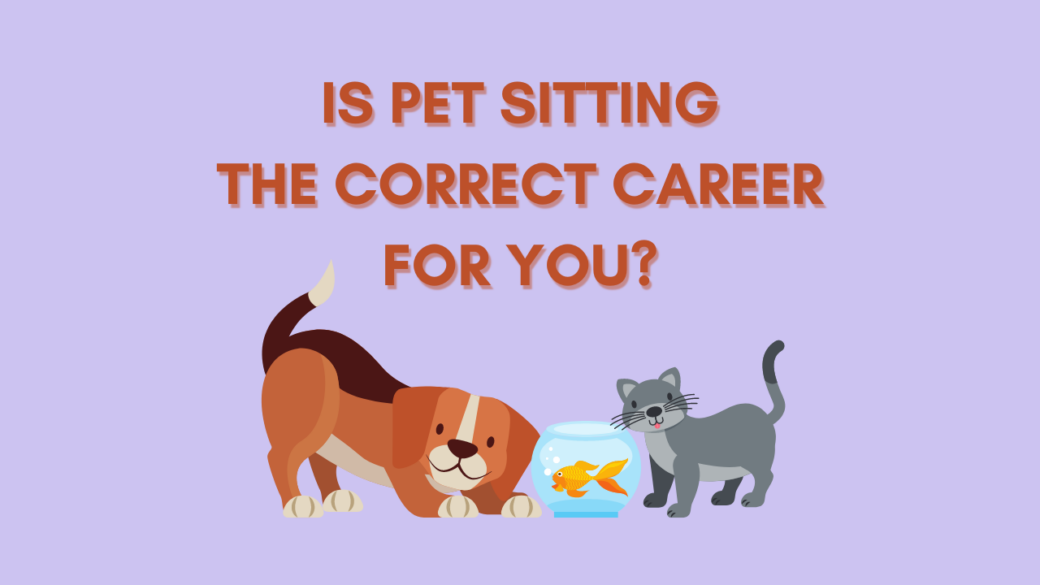Pet sitting has become a popular choice for those wanting to run their own business, and rightly so. Since the Covid pandemic, there has been an increase in the number of pets that became dependent on their owners’ presence; this was mostly due to the work-from-home guidance. With most people being back at work as normal now, their dogs, cats, and other animals have been left alone. As a result, pet parents have been hiring sitters and walkers.
Due to the rise in demand for pet sitters, more and more people have decided to enter this profession. Not only do people enjoy this job for the chance to work with animals, but it also gives them the opportunity to choose their own hours for a better work-life balance and income; these are a few of the most important factors to employees currently.
Before you decide to go ahead with a pet sitting job, you should understand the role you would be taking on. This article aims to outline the responsibilities and tasks of pet sitters to enable individuals interested in the profession to make an informed decision.
Table of Contents
What is a Pet Sitter?
Pet sitters care for a range of pet animals when their owners cannot; this might be due to a holiday or a work schedule. Dogs, cats, rabbits, and other pets can be cared for by pet sitters. A pet sitter will ensure all of the animal’s needs are met while the owner is away, including feeding and watering, exercising, etc. This work can be done by someone working for a professional pet sitting agency or a freelancer.
Simply put, a pet sitter is similar to a babysitter or childminder, but instead of watching human children, the pet sitter looks after furbabies. It can be a flexible role, allowing individuals to select their own hours, so many students or part-time workers who love animals choose to become pet sitters to receive an extra income.
What Does a Pet Sitter Do?
As briefly mentioned, pet sitters carry out various tasks to ensure the animal in their care is happy and healthy while its owner is absent. Pet sitting services often display the jobs they will complete on their websites or advertisements, but this can be difficult to do when you are first starting out, especially if you are freelancing.
The exact tasks you must carry out as a pet sitter will be decided when chatting with the pet owners. Some will want their pets to receive additional care, while others will just want the bare necessities completed. Most often, though, pet owners will ask sitters to carry out the following duties:
Ensure the animal has food and water
One of the most basic aspects of pet sitting is feeding and watering the animals in your care. This is more common when the owners are on holiday or work shifts, so they aren’t able to feed their pets at the usual time. Pet sitters are hired to ensure dogs, cats, and other pets have the correct amount of food and water, as outlined by the owners. Each pet parent should provide specific guidance on what their pets need, and this should be recorded for future use.
When you perform home visits in the local area, you will be able to visit multiple animals per day, ensuring each one has its basic needs met and more. This might require a car or public transport, depending on the size of your area.
Provide the pet with exercise
Depending on when the owner is away and how long for, some pets will require visits to allow for daily exercise. Pet sitters will allocate a set amount of time, usually in slots of 30 minutes to an hour, with each pet, and some of this time will go towards exercising the animals. For dogs, this could be a short walk, while cats might get the opportunity to play with the sitter.
Exercise also includes mental stimulation, not just physical. A pet sitter might spend a few minutes training a dog or using puzzle toys to keep their minds active.

As pet sitters can also provide the services of dog walkers, it isn’t uncommon for them to combine pet sitting services with a dog walking business. Unsurprisingly, this can be a physically demanding job, so you should be physically fit to be successful in this business. Think of all the dog breeds you might have to look after and ask yourself if you can control all sizes on a leash.
Show the pet affection
Spending time with animals has been shown to improve mental health, but pets also benefit from the attention and love they receive from pet sitters. A lot of animals form bonds with their humans, and so they crave human contact. When their owners are unable to provide this due to other commitments, a pet sitting business can step in to ensure the animals’ needs are met.
Although many animals will be cautious of a stranger at first, most will eventually settle down and accept this new presence. They are more likely to be comfortable if kept in their own home, which is often the case for pet sitting.
Groom the animal if required
There are some breeds of dogs and cats that require regular grooming; long-coated breeds, like the Bearded Collie dog or Maine Coon cat, need to be brushed often to prevent matting. Not only that but if a dog gets muddy on a walk, then it might be up to the sitter to ensure the dog is clean before its owner returns home.
However, if you cannot carry out this aspect of pet sitting, let your clients know beforehand to avoid disappointment. You could advertise your available services on a website or pet sitting profile.
Administer medication if necessary
If an animal in your care requires medication, then you might be asked to administer it. This can be a very delicate process, especially when using the correct dosage, so you must not take this task lightly. It can include oral medication and injections.
You might also be asked to carry out other tasks around the house, such as putting the bins out or watering plants if the owners are away for more than a few days. These additional roles can be agreed upon when speaking with clients.
With knowledge of what the pet sitting profession includes, you can make an informed decision on whether this is the right job for you.
How to Become a Pet Sitter
There are a number of ways to become a pet sitter in the UK, but most people will follow the same steps.
Gain experience working with animals
Relevant experience goes a long way in the pet sitting business. Many pet sitters love animals, either growing up with their own or enjoying time spent with their family and friends’s pets, so they have some firsthand experience. This should be expanded upon in a professional setting, though. Some ways people gain extra experience with animals include:
- Helping out dog walkers or trainers
- Offering to walk other people’s pets
- Volunteering at an animal kennel in the local area
When you first start out as a pet sitter, you should play to your strengths by focusing on where you have the most experience. For example, if you have never dealt with a ferret, you might want to avoid taking ferret owners on as clients. However, this does not mean you cannot offer this service eventually. By gaining additional experience over time, you could expand the types of animals you can care for.

Do you need qualifications?
Official qualifications are not a requirement in pet sitting for the most part; however, you could demonstrate your knowledge and skills to potential clients by gaining certificates and qualifications. Having qualifications in areas like animal first aid, for example, will make you a much more responsible pet sitter, and this could enhance your professional standing among pet owners in the area.
There are various courses new pet sitters can join to improve their training. Areas that should be prioritised include:
- Animal behaviour and/or psychology
- Animal care
- Animal first aid
- Dog walking
- Health and safety in the pet profession
- Pet grooming
- Pet nutrition
The National Pet College offers a range of courses for those wanting to work with pets.
Apply for a licence, if required
Although you do not require a licence if you are pet sitting in the owner’s home, you will require a home boarding licence if animals sometimes stay at your residence. Even if this is a one-off situation where the animal is housed in your own home overnight, this will still require a licence to be obtained.
As explained in this post, a boarding licence, including one specifically for a pet boarding service in a house, will outline the requirements of the premises and boarder. The requirements of this licence will vary depending on the local authority, but most list the number of pets someone can board at any one time, the type of conditions these animals should be kept in, and what information the boarder should take from the pets’ owners.
Complete a DBS check
If you hold a client’s keys to enter their home, you will need a DBS check, formerly known as a Criminal Record Check or CRB check. Many pet sitters will have a copy of their clients’ keys, allowing them to access properties when required, and the clients must have a great deal of trust in their pet sitter or dog walker. GOV.UK states that a DBS check will contain information on “spent and unspent convictions, cautions, reprimands and warnings that are held on the Police National Computer.”
Obtain the correct insurance cover
Insurance is recommended for anyone working as a pet sitter. There are types of insurance cover specifically for dog walkers, pet sitters, and other animal carers, which will protect you if anything goes wrong. As a pet sitter, you could lose a client’s key, an animal could be injured in your care, etc., and you could have to pay legal fees if you do not have the correct pet sitting insurance.
The main policy aspects for a pet insurance policy include:
- Care, Custody and Control
- Employer’s Liability Coverage
- Personal Accident and Illness Cover
- Public Liability Insurance
The safety of animals should be one of the top priorities of a pet sitter and dog walker, meaning adequate insurance coverage is essential.

To Sum Up
Pet sitting jobs can be fun and often come with many benefits, but a profession in this sector can also be challenging if you are unprepared. As pet sitters are in high demand, it is vital to put yourself in the best position to nab clients by going the extra mile. This means ensuring you have the right experience, you are licensed by your local council if necessary, you have the correct insurance, and you have completed a DBS check.
With these aspects under your belt, you will have a greater chance of success on this career path. Of course, this depends on gaining good client feedback, which you should gain through repeat business. If you can carry out the variety of tasks required in pet sitting, such as feeding and watering, exercising, and loving animals, then positive reviews should follow.
So, if you want to pet sit, you must understand how to become a pet sitter, including what services to offer and how to conduct business in a safe and legal manner.

